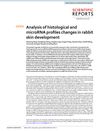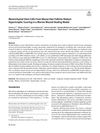Search
forLearn
1 / 1 resultsResearch
5 / 1000+ results
research Line-Field Confocal Optical Coherence Tomography In Alopecia Areata And Histopathological Correlation
LC-OCT is a useful noninvasive tool for diagnosing and monitoring alopecia areata.

research Analysis of Histological and MicroRNA Profiles Changes in Rabbit Skin Development
Rabbit skin analysis showed changes in hair growth and identified miRNAs that may regulate hair follicle development.

research Advancements in Non-Laser Energy-Based Devices in Trichology: A Comprehensive Review
Non-laser devices show promise in treating hair issues, but more research is needed.
research Investigation of Transcriptional Gene Profiling in Normal Murine Hair Follicular Substructures Using Next-Generation Sequencing to Provide Potential Insights into Skin Disease
Hair follicles have a more inactive cell cycle than other skin cells, which may help develop targeted therapies for skin diseases and cancer.

research Mesenchymal Stem Cells From Mouse Hair Follicles Reduce Hypertrophic Scarring in a Murine Wound Healing Model
Mouse stem cells from hair follicles can improve wound healing and reduce scarring.
Community Join
5 / 9 resultscommunity "Hair Follicle Stem Cells are quiescent 99% of the time and permanently reside in the hair follicle"
Hair follicles are mostly dormant but can be reactivated with treatments like minoxidil, finasteride, and microneedling. A new drug, PP405, shows promise for hair regrowth but may not be available until 2027-2028.
community Bruteforcing alopecia or the new advent of science progress
Combining therapies like scyllo-inositol, alpha-ketoglutarate, and autophagy-inducing supplements may enhance hair growth and prevent hair loss. Reporting individual results can accelerate progress in hair loss treatments.
community The PP405 news are the best news we've had in the last 20 or more years.
PP405 significantly improves hair density, outperforming finasteride, with 31% of users seeing over 20% improvement in four weeks. Concerns exist about its availability, cost, and long-term effects.
community Confused why people are calling PP405 a cure...it never claimed to be able to undo miniaturization or revert vellus back to terminal hairs. It seems to be more of a growth stimulant like minoxidil.
PP405 is not a cure for hair loss but may reactivate dormant hair follicles, similar to minoxidil. It is unlikely to help with miniaturized or vellus hairs and is still in trial phases, with availability expected around 2030.

community Compressed part of research of theory of androgenic/anabolitic balance. AGA h-responders analytic. Theory of physio-metabolitic method of anti AGA treatment
The treatment for androgenetic alopecia involves using finasteride and minoxidil with intense exercise and cold exposure to boost metabolism and reduce androgenic effects, potentially leading to hair regrowth. This approach may activate biological pathways for improved hair and overall health.